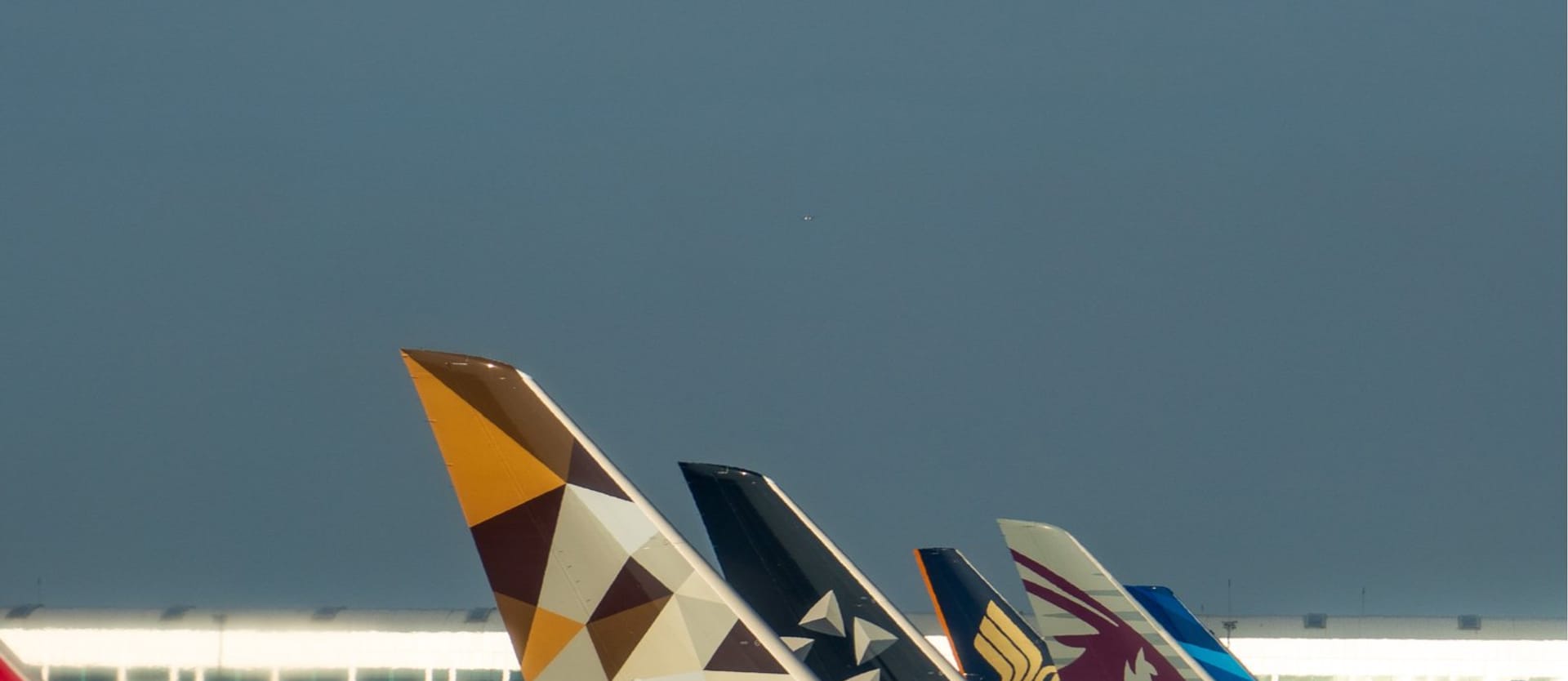The digitization of airline marketing is no longer news; it has matured into nuanced customer targeting. Nuanced advertising means that air carriers are working harder to differentiate themselves in a crowded market. Aviation leaders predict for 2024 that the travel industry is set for peak competition that will spoil flyers with all the choices the year will bring.
So airlines are now recalibrating their plans to align with evolving consumer tastes and expectations. Enhancing online booking systems, reimagining social interactions, and turbocharging technology investments are at the forefront of their strategies.
In keeping with the times, the aim of this article is to explain how airlines market their products. We’ll cover marketing best practices and approaches by segments addressing real-world cases where possible.
What is airline marketing?
An airline marketing strategy is an overall business plan that aims to reach prospective consumers, turn them into customers, and keep existing ones engaged. When systematically planned, the strategy covers the four Ps of marketing: product, price, place, and promotion.
As in other industries, airline advertising and marketing strategies revolve around a value proposition. For example, Ryanair – an Irish low-cost carrier – has a value proposition that sounds like this “low fares airline.” And it perfectly communicates to the customers what the company stands for and how it operates.
The high-level goal of a marketing and advertising strategy for any airline is to achieve a winning advantage over competitors. It involves understanding customers' needs and adjusting the tactics to meet them. We’ll discuss some marketing strategies airlines adopt that help increase their revenue and stay afloat.
Understanding the air travel market
Before diving into the approaches to building an airline marketing strategy, let's understand the industry's impact on marketing, how the air travel market works, and what problems airlines are addressing.
How airlines shaped modern marketing
The airline industry has impacted how we buy things today and how those things are marketed. Here are just a couple of examples: Electronic tickets were first developed for fare ticketing, while one of the first online booking systems was built by airline distribution company SABRE. Airline companies were also the first to practice eCommerce by founding and operating online travel agencies (OTAs).
Driven by insane competition, airlines relied on many tools to survive in the market. Not even considering innovative technologies themselves, marketing plays a huge role in running a business successfully. Since the way people live and travel changed drastically, the industry had to adjust to modern world conditions. Instead of smoking onboard, luxurious service, and premium class flights, low-cost travel is now king.
Marketing is multi-dimensional, especially in the airline industry. At a bare minimum, the same products are sold to customers (leisure and business) and distributors differently.
Key players
The airline market has three big categories of players.
Airline companies themselves.
Distributors are all the third-party companies that resell travel products to end customers (OTAs) or other intermediaries (wholesalers). A central point of connection between airlines and distributors is Global Distribution Systems (GDSs). You can learn more about them in our video.
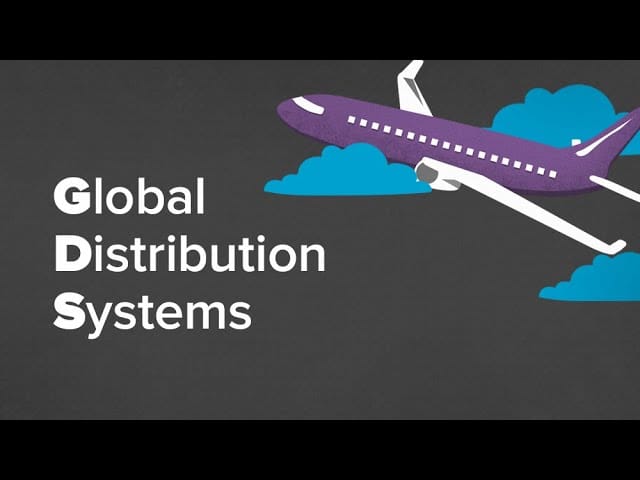

How airline distribution works in a nutshell
Customers are buyers of travel products who are traditionally divided into segments of leisure and business.
- Leisure travelers are the largest channel of sales. It requires serious technological infrastructure to operate in that sector. This segment is budget-conscious, so customers are primarily interested in optimal pricing rather than additional services or higher service classes.
- Business/corporate travelers are people, individuals, or groups that travel mainly for business. The chief priority here is an optimal route choice and comfort, so a high service class is preferable. While business travelers occupy a much smaller part of flights, they typically bring more total revenue compared to leisure travel approaches.
As airlines sell their services both on direct and indirect channels, relations with distributors are also a part of marketing. Now, let’s talk about the challenges airlines face in marketing their products.
Challenges of the air travel market
Given the market conditions, airlines have many opportunities to target different customer segments through direct and indirect channels. However, some complexities challenge building an effective marketing strategy.
Airlines are selling a service. While an airline ticket is a tangible thing (at least a paper one), the rest of the trip is a service. Services are difficult to market since you can’t touch, taste, or smell them, nor can they be explained in two words.
Travel products are perishable. Tickets and ancillaries expire. The price of the same ticket fluctuates due to various factors, so there is no constant value proposed to the user. The price offer is always dynamic depending on the current demand and how long before departure we sell the ticket. All these things are worth a separate discussion, so you can watch our dynamic pricing video.
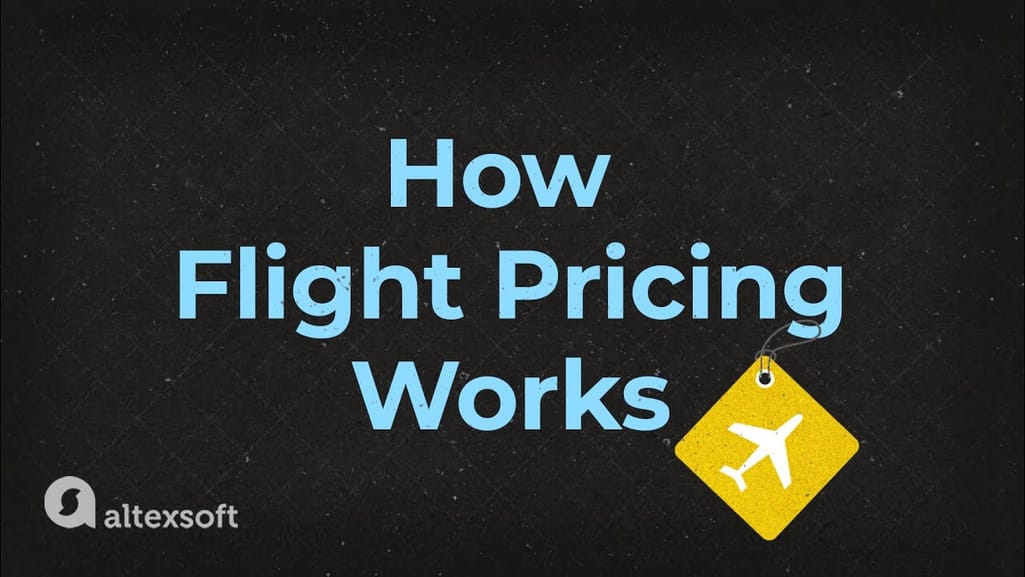

A short explanation of how dynamic pricing works
Globally volatile. Airlines operate across the globe, and that presents difficulties. A flight destination and country can be either a marketing opportunity or an obstacle. Carriers are vulnerable to political, economic, geosocial, and climate factors, making it hard to plan marketing campaigns and advertise products.
Data loss on indirect channels. The end point of sales is travelers. But, it does make a big difference in how airlines sell their flights: via a direct channel (reservation on an airline website/app), or a distributor. Direct sales bring an airline a lot of benefits, like customer data and the ability to market products using this data. Trading via online travel agencies and global distribution systems is completely different. First, carriers pay commissions as a percentage of a fare/service price. Secondly, airlines are cut off from the customer data that stays in the hands of middlemen.
Let’s talk about the actual perks of digital marketing in the airline business.
Benefits of digital marketing for the aviation industry
The airline sector has progressed since adopting digital approaches to advertise travel. Here are the advantages gained so far.
Establishing closer connections with travelers. Not so long ago, airlines had to jump through hoops to relay a simple message because of outdated call centers. Fast forward to now, and they’re leveraging digital channels, such as their websites, social media, and emails, to elevate customer engagement directly. This shift means they can quickly tackle queries, offer promos, and absorb feedback to foster a closer bond with each traveler.
Targeted advertising. Before digital took off, airline advertising was a shot in the dark, with billboards and TV ads often missing the target. Nowadays, airlines are focusing on users' preferences and online behaviors to ensure their ads genuinely engage customers' interests rather than being ignored.
Cost-effectiveness. Splurging on broad-spectrum ads used to be the norm. It was a pricey gamble with no guaranteed returns. Today, airlines can employ budget-friendly strategies to draw in customers while expanding their network, all thanks to digital marketing's precision and affordability. For instance, using social media to build a brand is cheap or free, making it beneficial for emerging travel companies that want to minimize spending.
Real-time data and analytics. Waiting in the wings for campaign results is history. These days, airliners can track their digital campaigns in real-time and get instant feedback. This allows them to adjust and stay aligned with traveler trends quickly.
Increased reach. Marketing was limited by how far a budget could stretch across borders. Digital has shattered those boundaries, empowering aviation firms to cast their net far and wide while touching down in markets previously outside their horizon.
Airline marketing strategies: Improvements and new approaches
As we've mentioned, the methods used by carriers to pitch their services and the way travelers react are forever changing. Below, you'll find advertising tactics airliners are putting into play.
Cooperating with metasearch engines to drive more sales
Working with distribution channels is one of the most important parts of airline marketing. Metasearch engines occupy a specific place in air travel because they allow travelers to search flights among thousands of suppliers and compare prices. All the competing airlines are here, so customer-wise, it’s really handy.
Until recently, metasearch engines only allowed visitors to view prices and then redirected them to an OTA or airline’s website to complete flight booking. Now, it is sometimes possible to buy air tickets right on the metasearch platform.
Speaking of metasearch engines, it’s difficult to ignore Google. Google Flights appeared in 2011 as a metasearch, which allows users to look for and compare fares. Now, things look a bit different for two reasons:
- Searching for a flight destination via a Google search page will show you the results of Google Flights right away. For example, if you search “Google Flights India,” Google shows you flights to, from, or within India. You can then enter your departure city, destination, and travel dates to compare options and prices. So there is no need to go on airline.com to see the prices.
- Google doesn’t offer direct booking, but it facilitates the process. When you choose a fare on Google Flights, it will offer you some booking options. Most often, it will redirect you to the airline.com page, but sometimes it offers booking via an OTA.
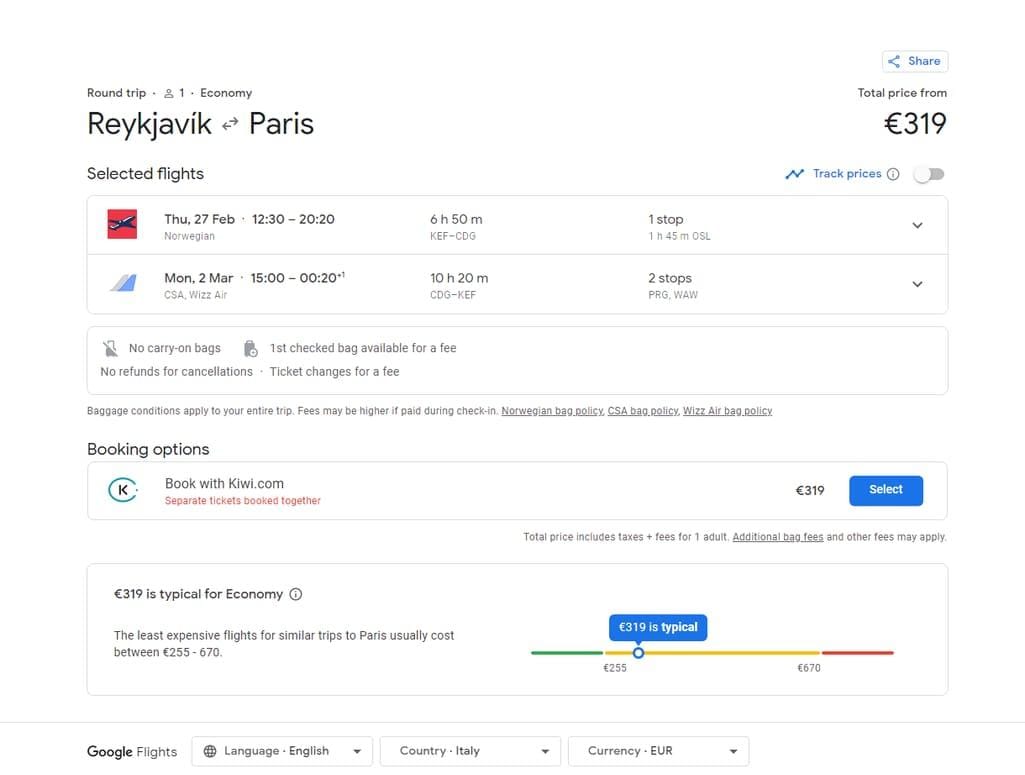
Metasearch engines make it easy for airlines to drive more sales because, in most cases, they offer travelers a direct booking option without fees and increase the visibility of fares on the global market. In the case of Google, the cheapest option for a certain destination will be shown right on the search page.
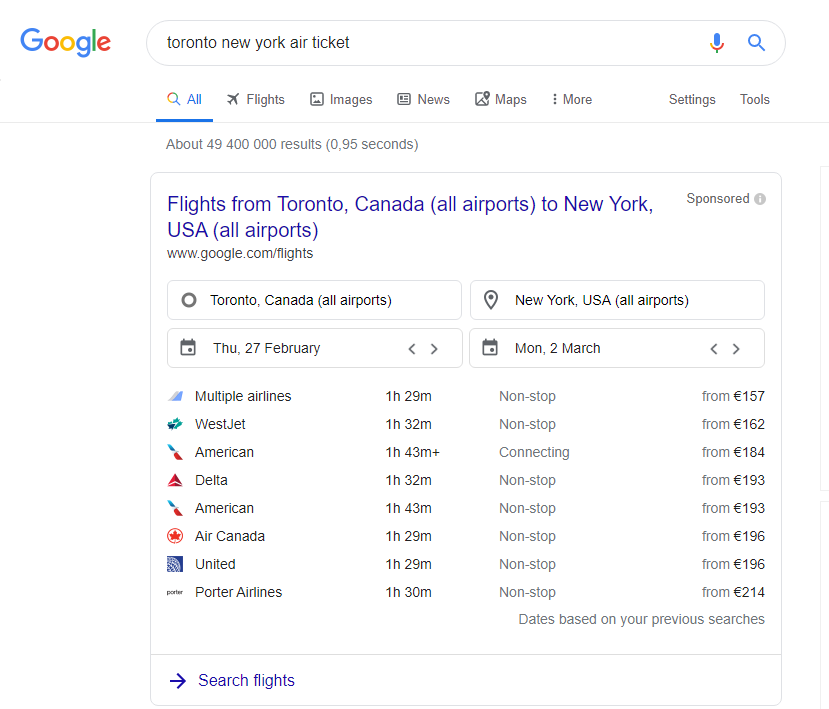
A more unusual case of working with metasearch engines is that of Icelandair. It experimented with showing other airlines' flights on their own website. The purpose of the test was to show that Icelandair tickets can be cheaper, but the idea didn’t go anywhere. However, this case is an interesting slant on positioning in the market.
Building customer loyalty via frequent flyer programs
Each airline is concerned with rewarding its loyal customers. One of the most common and effective ways to cater to regular flyers is loyalty programs. The scenario is quite straightforward: Travelers collect bonus points that can be turned into purchases or discounts in the future.
But it is not only about accumulating enough miles to receive a free flight. Loyal customers can earn points when spending money on things like renting cars, booking cruises, using credit cards (when a bank co-brands with an airline), and other marketing partner services.
Also, the number of mile points now relies on how much a customer spent on a flight — the higher the ticket price, the more points you get. So, frequent flyer programs offer incredible profit opportunities for airlines in the first place.
As for general loyalty programs, we want to focus on American Express (Amex) as one of the largest corporate travel providers globally. American Express offers an affiliate program for airline companies. Using an Amex card, travelers can get discount points by purchasing one of many affiliate member fares.
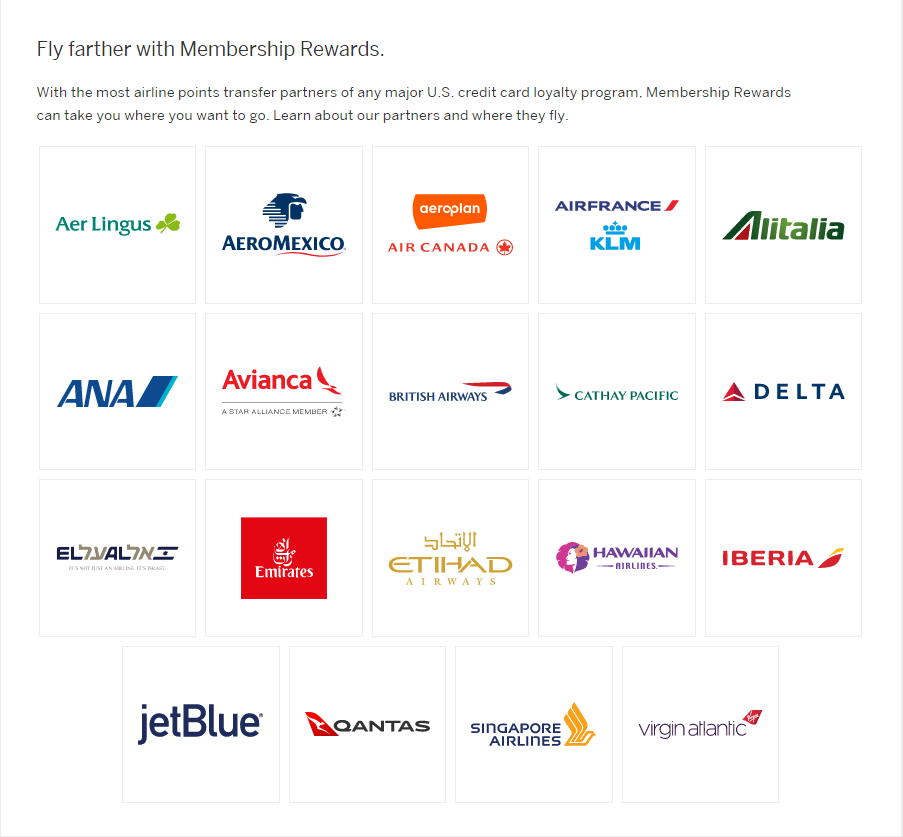
A list of airline members
Source: www.americanexpress.com
The points accumulated while using an Amex card to pay for airfare can be spent in many online stores, including Amazon and Dell. So, it might be even more profitable, as Amex loyalty programs permit a more diverse spend of points.
Utilizing blog posts to promote budget destinations
Blogging is exceptionally relevant in marketing. Consider it an effective outlet for personalizing content through search optimization. Airlines use SEO to tailor their web content so that it matches what travelers search.
For instance, if a user searches for "affordable flights to Paris," an airline with optimized content for these keywords can appear prominently in the search results.
A prime illustration of blogging in action is seen with Ethiopian Airlines. Visitors to their blog are immediately greeted with articles that promote their destinations, holidays, and travel tips, among other features.
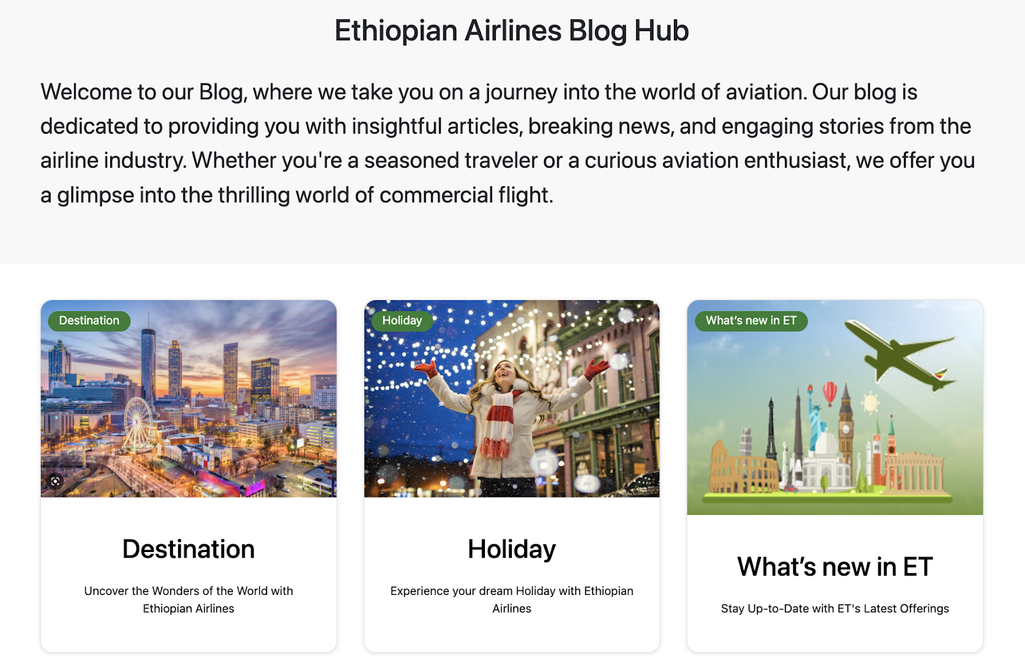
Ethiopian Airlines' blog shows smart use of content for service promotion
Irish low-cost Ryanair operating across Europe, is another example. Low-cost airlines target cost-sensitive leisure travelers, using the lowest prices.
To enhance this airline marketing strategy, Ryanair utilizes its blog to make travel reviews, give travel tips, and promote budget destinations. This way, the carrier inspires customers to travel cheaply with Ryanair.
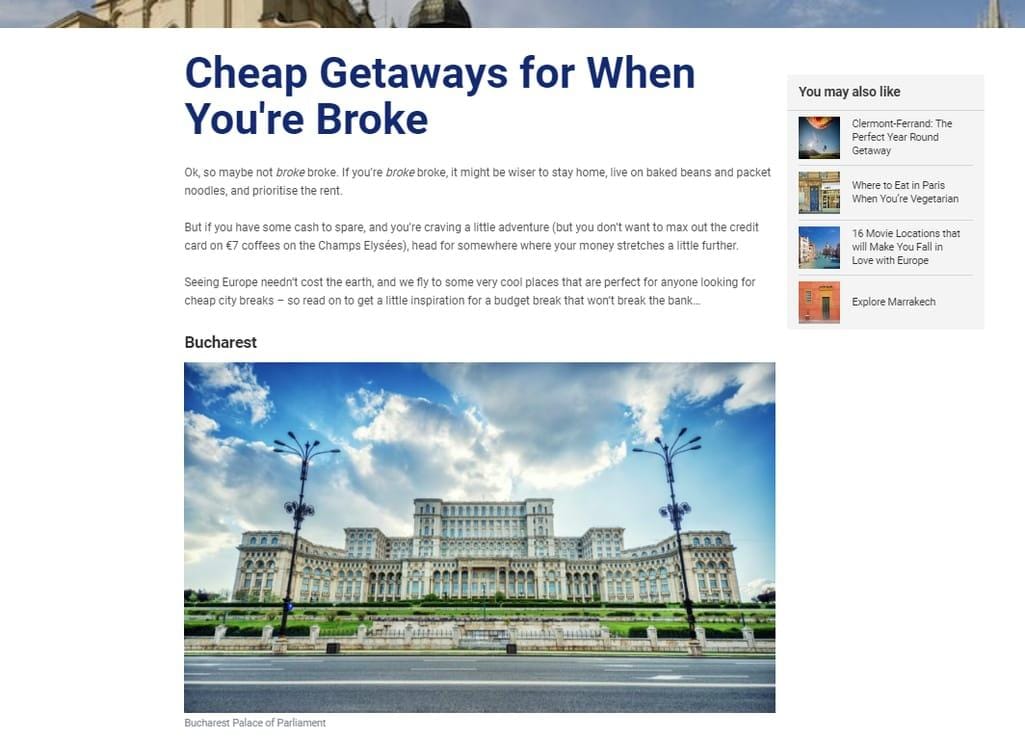
Given that price sensitivity is high across leisure travelers, Ryanair understands that affordable flights may make a compelling argument.
Integrating social networks as a part of the travel experience
KLM Royal Dutch Airlines is a flagship carrier of the Netherlands operating to over 150 destinations. In 2009, it pioneered the use of social networks to send customers their flight documentation via WhatsApp, Twitter, and Facebook Messenger.
In 2012, KLM introduced Meet & Seat, a social media campaign that allowed passengers to connect through Facebook or LinkedIn. It enabled travelers to link their Facebook profile to their seat selection, making it visible to fellow passengers.
Apart from the efforts of companies like KLM in engaging passengers through social media, airlines are increasingly focusing on crafting genuinely authentic feeds. Sprout Social's 2024 report shows a growing demand for genuine, non-promotional brand content.
Many carriers are using the actual voices of their own employees. Delta Airlines, for example, is actively encouraging its team to generate social media content related to its services. In a notable move, a video on Delta's Instagram account featured employees leading a language lesson, which introduces a touch of authenticity rarely seen in airline social media marketing.
A new trend also gaining momentum involves creating more engaging, fun content. The previously dominant "edgy" brand tone is replaced by a willingness to explore playful and light-hearted forms. Airlines are creatively engaging with meme culture and internet humor in ways that align with their brand identity.
Southwest Airlines, for instance, capitalized on a universally relatable travel experience to produce the meme video, which effectively connected with viewers through a mix of humor and originality. Check our video to learn what makes Southwest one of the most loved American carriers.
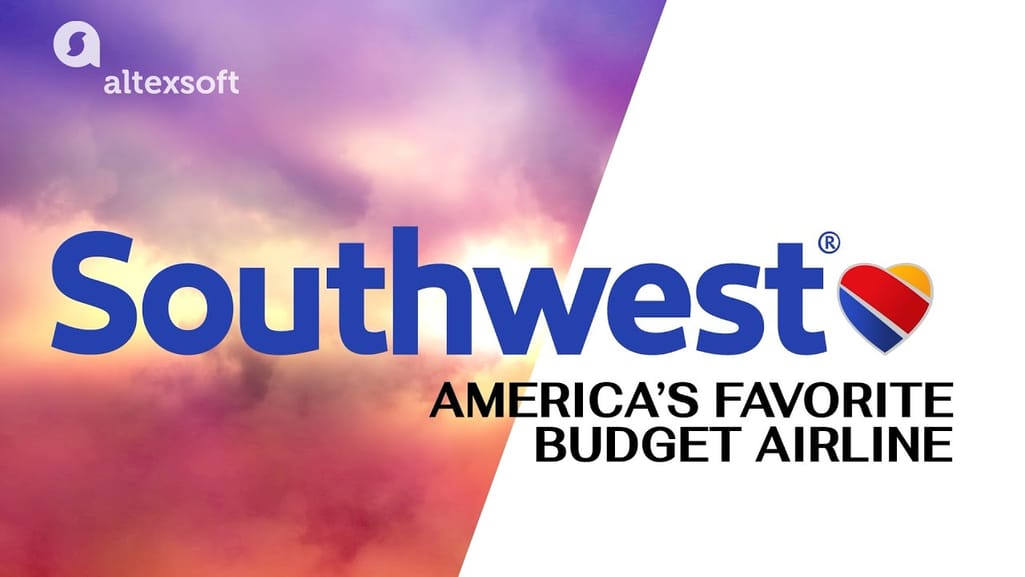

The Southwest success story
Live analytics to explore and engage with the target audience
American Airlines (AA) is the world’s largest carrier by passengers carried. Merged with US Airways in 2013, AA now owns 957 aircraft operating globally, which makes it the second largest commercial airline fleet — after Delta Air Lines.
In 2017, social networks became a standard way to communicate with large brands and companies. AA built an interactive map with geo-markers to track the location from where America was mentioned on the web. The use of real-time tracking of social mentions made geotargeting simpler, keeping in touch with its loyaI customers in the bargain.
Fostering user-generated content to increase customer engagement
In 2014, a flagship carrier of Singapore announced a large cooperation campaign between the Australian media agency MEC and Singapore Airlines. The activity was named The Storytellers. The idea was to pick 4 journalists and bring them to one of Singapore Airlines’ available exotic destinations. The journalists were tasked with documenting their trip and travel experience in written and video format. The content gathered was hosted on the dedicated hub at MEC’s website. And all the interested viewers could vote, with the number of votes indicating a winner.
Fostering user-generated content is one of the simplest ways to boost user interaction with your brand. But, on a much deeper level, that campaign helped Singapore promote its tickets and chosen travel destinations as one of its products.
The Nosto and Air France partnership is another case that exemplifies the continuous impact of user-generated content (UGC).
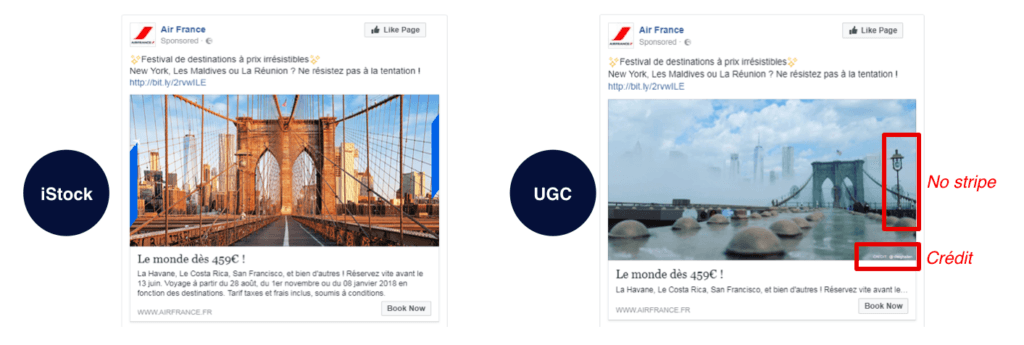
Side-by-side comparison of user-generated images used by Nosto for Air France's Facebook ads
Nosto, an AI-powered Commerce Experience Platform (CXP) recently shared a case study, where campaigns with user-generated photos for Air France outperformed those with brand-designed images. It resulted in a 4 percent increase in click-through rates (CTR) and a 3 percent reduction in cost per click (CPC).
Promoting a small number of ultra-low fares to foster purchases
This case with low-cost airlines is a smart marketing move. When the flight booking opens, the occupancy is low, so the price is also low to foster purchases. Low-cost airlines promote those low prices on dedicated platforms to start the buzz around "insane offers".
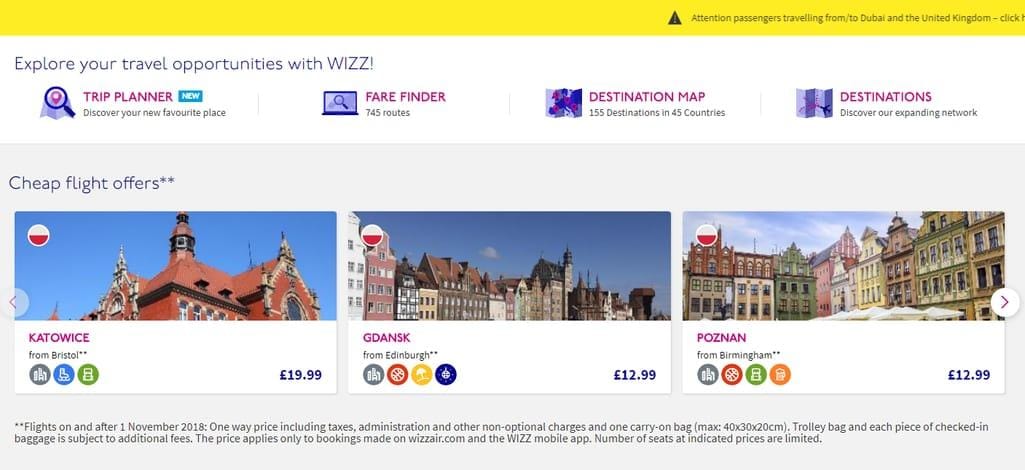
A price for the destination in general may seem incredibly low. So, here’s the trick: The given rate is just a small number of fares that will be available until the occupancy increases. Then, it will appear on different distribution platforms, media resources, social networks, and “special deal” aggregators. However, this fare bucket will be closed, so the average fare for this flight will be much higher.
By promoting ultra-low-cost flights, carriers make headlines and increase the number of travelers visiting their websites, even though only a handful of them will fly so cheaply.
Advertising stopover destinations
Marketing in business is most often associated with product advertising. A great example of how travel products are promoted can be seen in the Icelandair Stopover Campaign. The really old campaign was launched in the 1960s and spiraled to its highest popularity in the 2000s. In a nutshell, it allows travelers to make a 3-day stop in Iceland on the way to European or North American cities.
You can find numerous ads dedicated to its Stopover campaign, promoting different sides of its service.


One of Icelandair's video ads to its Stopover Campaign
The campaign became increasingly popular among leisure travelers, as it allowed for visiting a new country on the way to your final destination. Then pack your bags, make a transfer, and you’re back to your home or destination city. Icelandair opened up an accessible route for tourism both for European and American travelers. Using its own infrastructure of hotels in Reykjavik, Icelandair Stopover quickly became its primary marketing engine that boosted both sales and created a base of loyal customers.
Turkish Airlines is another airline that’s popular for its stop-over program is Turkish Airlines. In the scope of the stopover in Istanbul program, passengers with a connection period of at least 20 hours can stay free of charge and accumulate unforgettable memories in Istanbul, famous for its historical and cultural heritage. Turkish Airlines partners with hotels to allow travelers to stay and enjoy activities specific to Istanbul.
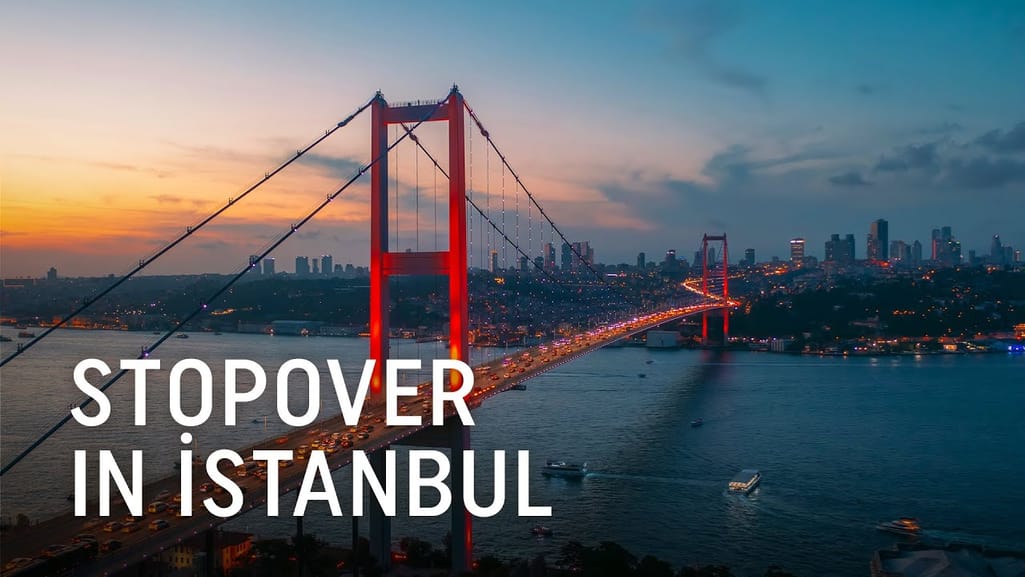

Leveraging airline affiliate programs
Airlines launch affiliate programs to boost their flight promotions and travel deals by enlisting affiliate marketers to spread the word online. These marketers, using their websites, blogs, and social media, help airlines reach a wider audience.
In exchange, affiliates are paid commissions for directing traffic, sales, and bookings to the airlines.
An example of this is Etihad's affiliate program. Etihad Airways is a flagship carrier of the UAE, known for luxury in the sky. Based in Abu Dhabi, it flies to destinations worldwide and offers a range of flight classes.
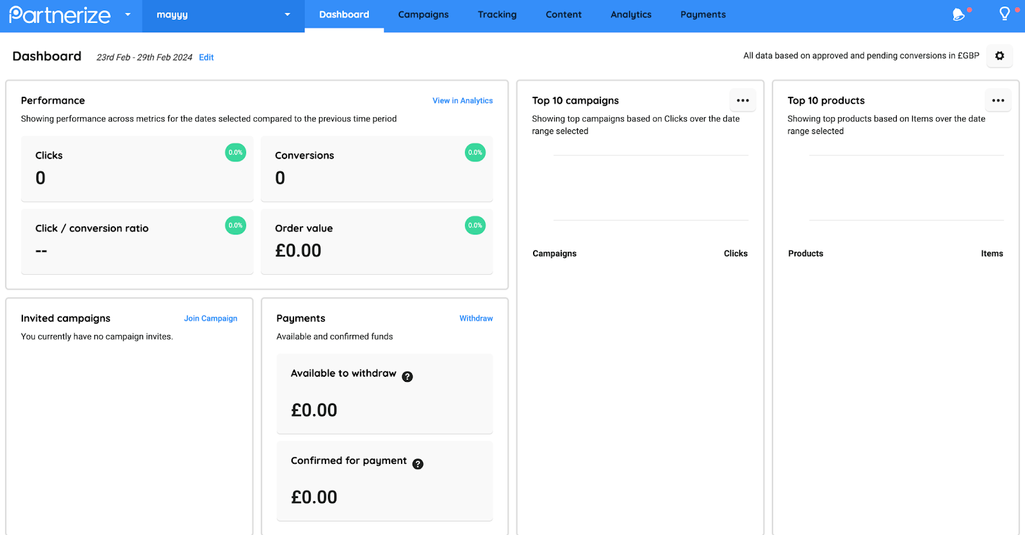
A dashboard view of the Etihad Affiliate Program using Partnerize software
The airline's affiliate program, in collaboration with Partnerize, provides an opportunity for publishers to earn commissions by promoting their favorite products. When a customer books a flight through an affiliate link and finalizes their reservation, the publisher receives a portion of the fees.
Introducing gamification to immerse travelers
Gamification means turning something into a game-like process with rules, targets, and rewards. Flight companies have woven this concept into their marketing in a couple of clever ways.
First, by promoting their loyalty programs. Delta SkyMiles, Delta Air Lines' popular loyalty program, awards users points for booking flights, checking in, and completing activities such as watching short videos.
Second, by offering an immersive experience. Nearly a decade ago, Air France transformed the travel experience into a game through the mobile app Cloud Slicer. This game is basically a competition playground for passengers to play for a “service-class upgrade.”
Although Cloud Slicer is now retired, the initiative enabled Air France to engage customers in a gamified journey and showcase its latest aircraft and business class offerings.
Being ready to respond to global events and changes
Airlines must anticipate the changes and be ready for when they occur. The global pandemic has proved that the ability to quickly adjust to new realities is what separates successful companies. Apart from the changing aviation environment, strategic planning should be a continuous process that considers customer demands.
Today, you can see a shift in priorities for travelers who prefer flying. People are more likely to fly with carriers that provide a safe journey. Taking this into account, airlines are changing the messages their brands communicate. Many carriers adapt their marketing campaigns to assure passengers that traveling with them is safe despite the changes in the flying experience overall. Digital technologies help carriers keep up with changes and provide safety. Such technologies mainly focus on contactless and self-service travel experiences.
They include the following.
Online check-in and check-in kiosks provide passengers with the opportunity to conduct the whole checking-in process online or via special kiosks placed at airports. The boarding pass can be saved onto the phone while the baggage claim tag can be printed out by the kiosk – all of this without the need for close contact with other people.
Contactless bag handling enables people to check-in, drop off, and track their baggage without or almost without any interaction with airport personnel.
Automated border and passport control powered by ePassports, biometrics, and eGates allows travelers to pass the identity checks more quickly and, of course, safely.
Many carriers have already implemented these tech solutions and changed their marketing strategies to show customers that they put the safety of passengers first. For example, Singapore Airlines' latest airline marketing campaign focuses on an “elevated experience,” meaning the carrier takes care of all the health and safety measures at all touch-points to relieve passenger travel anxieties. Digital innovations include various options like online check-in, contactless kiosks, and automated bag drop.
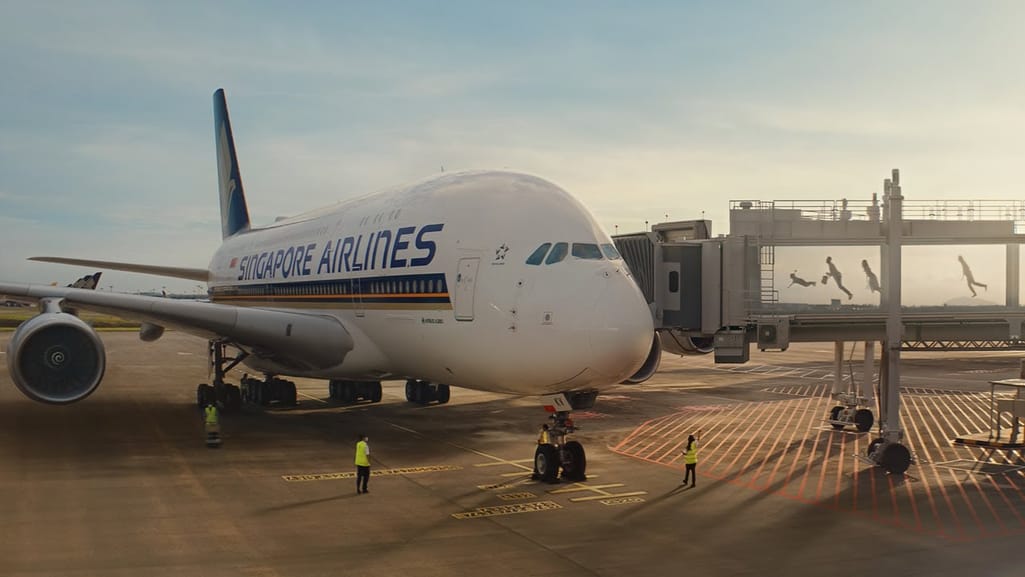

Singapore Airlines commercial
The airline’s marketing and advertising campaign takes away the stress of pandemic-era flying, emphasizing peace of mind.
Using celebrity endorsements to increase brand visibility
Airlines could also collaborate with influencers to promote their services and destinations on platforms like Instagram, YouTube, and TikTok. Influencers share their travel experiences with their followers, adding a personal touch that effectively endorses and attracts a wide audience.
The exposure converts into bookings as followers, inspired by the influencer's stories are swayed to choose the airline for their next trip.
Certain airlines are considerably invested in influencer marketing. For example, British Airways has always run powerful ads. It is a major UK carrier, considered an air symbol of Britain, like American Airlines for the US. And it’s also famous for its TV commercials, as some became advertising classics.
The latest safety commercial, featuring numerous well-known British actors, musicians, and media stars, certainly brings home the BA brand as a national symbol.


British Airways 2019 commercial “Made in Britain”
But Emirates sets the gold standard for influencer marketing to advertise their luxurious in-flight experience and global destinations. In the commercial below, you can see Real Madrid players —Thibaut Courtois, Nacho Fernandez, Vinicius Junior, and Rodrygo.


Emirates’ ‘Fly Better’ commercial featuring Real Madrid players
Launching sustainability and ethical projects a.k.a. green flying
As eco-awareness takes flight, airlines spotlight green moves, like reducing carbon emissions and switching to sustainable fuels.
The push to achieve this has made the sustainable aviation fuel (SAF) market a key, fast-growing part of the industry.
According to a recent Research And Markets report, the European SAF market is anticipated to reach $18.23 billion by 2033, with a CAGR of 58.03 percent.
Leading this trend, companies like United Airlines are actively incorporating SAF into their operations and initiating campaigns to raise awareness about carbon neutrality.
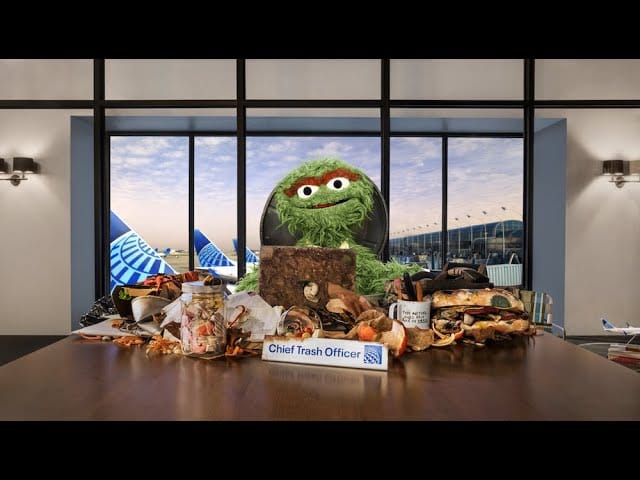

United Airlines’ commercial on sustainability
Going green in marketing isn't just good karma; it appeals to a growing number of eco-conscious passengers. Airlines showcasing their environmental efforts not only boost their image but can also sway travelers to choose them.
Integrating virtual and augmented Reality
Virtual and Augmented Reality (VR/AR), once a booming trend, saw a dip in popularity but is now making a resurgence in the airline industry.
The immersive experiences created by these technologies provide passengers with virtual tours of destinations, a peek inside aircraft cabins, or in-flight entertainment before they even board. Airlines are eagerly embracing this innovation to catch the eyes of travelers and kindle their travel aspirations.
Offering a glimpse into what lies ahead fuels excitement and anticipation, potentially leading to increased bookings and strengthened loyalty.
While Emirates was one of the first airlines to introduce VR technology in 2018, it wasn't until 2022 that the company rolled out a major campaign about the first VR app. It gives customers a realistic look at the Emirates’ First Class Suite and other products. Different air brands are now starting to follow suit.
More recently, Qatar Airways has taken the digital experience a step further with Qverse Metaverse. Initially, Qverse introduced users to exclusive areas such as Hamad International's premium zone and the Boeing 777-300's Qsuite and economy sections.
It has now expanded to include virtual tours of the Boeing 787-9 and Airbus A350-1000 cabins, plus a peek into the posh First and Business Class lounges at the airport. Guided by a virtual hostess, each spot offers a personalized deep dive.
Hainan Airlines, based in Beijing, has begun offering passengers on select flights the opportunity to use Rokid's augmented reality glasses at no extra cost for in-flight entertainment. This initiative by the Chinese startup Rokid marks the first large-scale use of AR glasses on flights. The glasses lets users see digital images overlaid uniquely in the real world. They can enjoy 3D movies, read e-books, and play games, a real departure from the traditional seat-back screens.
As tech giants like Apple and Meta push forward with innovations in extended reality (XR) technologies, the market may soon show a preference for specific brands.
If the battle for dominance in the XR space becomes a viral sensation and draws significant public interest, airlines might look to capitalize on the trend by incorporating devices like the Apple Vision Pro or Meta Quest in their in-flight entertainment options.
Alternatively, if the interest in XR technology independently becomes a massive trend without the competitive buzz, more airlines could still adopt these technologies to enhance the passenger experience.
How to plan a marketing strategy for your own airline company?
Speaking about real-world examples, we can clearly see where the roots of a marketing campaign are coming from. In fact, nearly all the mentioned airlines derive marketing activities from their required target group or demand to promote a new product.
There is no single way to create a marketing campaign because it involves a lot of company-specific details. But, let’s briefly sum up some valuable points that can help you.
Stick with your customer segment. Business and corporate travelers differ in their travel behavior and priorities. So, running a marketing campaign should highlight this factor as a primary concern.
Focus on the product you’re going to market. This point assumes you’re considering all the possible product dimensions (digital, physical, service), how you want it to market, what your secondary aims are, and how you benefit from customer actions.
Foster as much interaction with your travelers as possible. Not only does it help to build loyalty and establish human relations with your brand, it can also help you source valuable data about your customers and create a personalized experience for them in the future.
Be loyal. As long as you’re not an ultra-low-cost airline operator, you will probably have to reward the loyalty your frequent travelers give you. Loyalty programs, special offers, and discounts make your brand a company to stick with.
Keep an eye on competitors. As the airline market is fueled by competition, any marketing strategy should include two key elements: our market position and our competitors.
Maintain a balance between competition and customer loyalty. Discover the happy medium whatever the situation. Marketing in aviation is no exception. In the heat of competition, remember that existing loyal customers may be more important prospects
